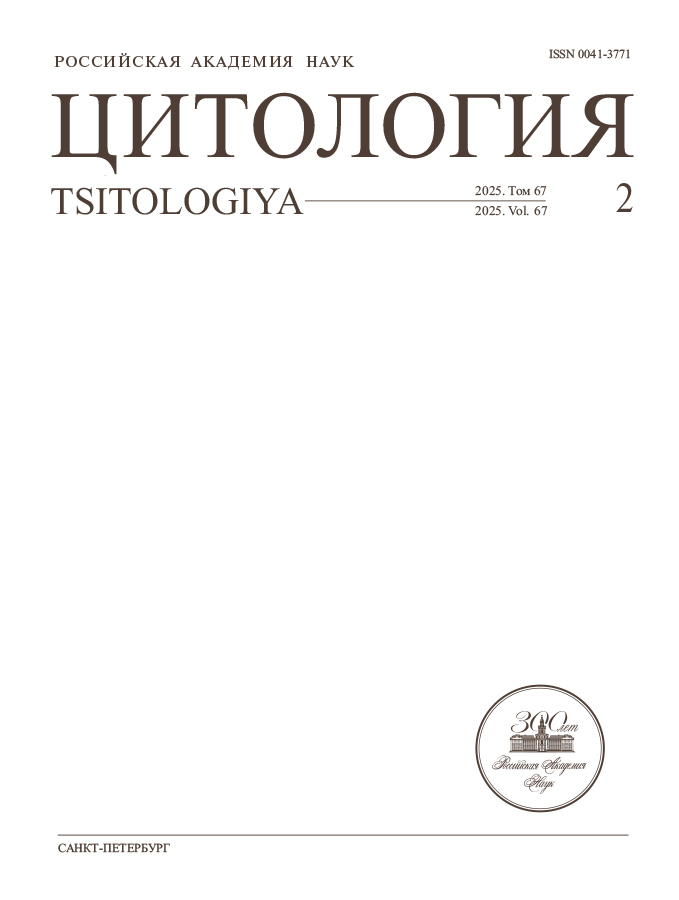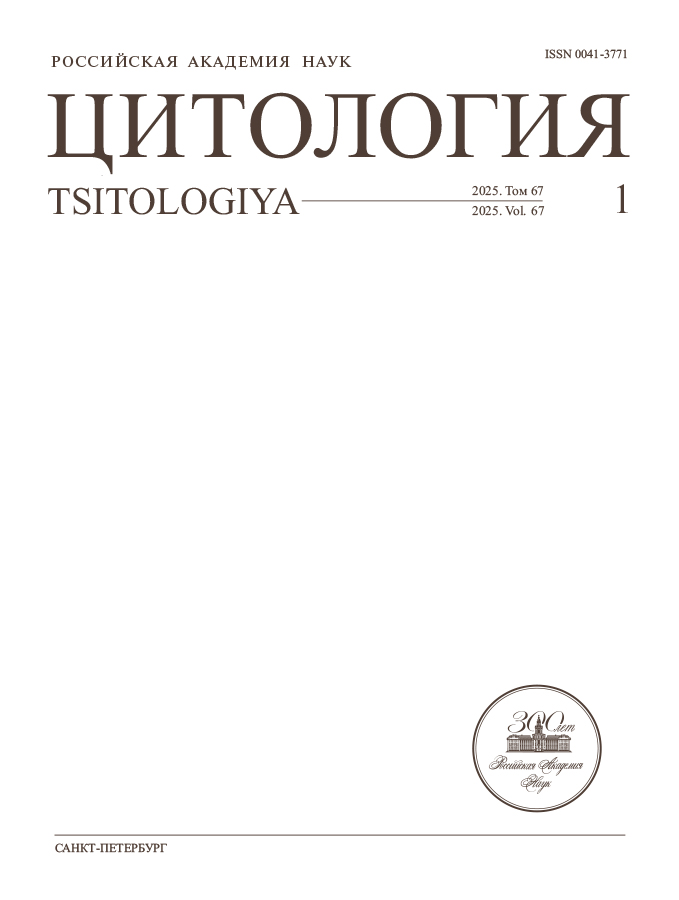Redox status and accumulation of autophagosomes in the liver of mouse under the action of lithium chloride
- Authors: Dmitrieva S.А.1, Ponomareva A.A.1
-
Affiliations:
- FRC Kazan Scientific Center, Russian Academy of Sciences
- Issue: Vol 67, No 1 (2025)
- Pages: 30-41
- Section: Articles
- URL: https://cardiosomatics.orscience.ru/0041-3771/article/view/682171
- DOI: https://doi.org/10.31857/S0041377125010031
- EDN: https://elibrary.ru/DEYARN
- ID: 682171
Cite item
Abstract
Activation of autophagy is considered one of the promising strategies for the treatment and prevention of various non-infectious liver diseases. In this work, we assessed the changes in redox status and autophagy activation in liver tissues in vivo under the action of lithium chloride. It was shown that lithium chloride leads to the accumulation of autophagosomes in liver cells under normal conditions. This process is accompanied by a slight increase in the activity of several antioxidant enzymes. Toxic effects on the liver and the development of oxidative stress with 3-day use of LiCl were not detected. Significant rearrangements in the ultrastructure of the endoplasmic reticulum were observed, which can play a signaling role and participate in the initiation of autophagy. Thus, oral application of lithium chloride can be used as an effective modulator of the autophagy process in liver tissues.
Keywords
Full Text
About the authors
S. А. Dmitrieva
FRC Kazan Scientific Center, Russian Academy of Sciences
Author for correspondence.
Email: s_dmitrieva@list.ru
Kazan Institute of Biochemistry and Biophysics
Russian Federation, 420111, KazanA. A. Ponomareva
FRC Kazan Scientific Center, Russian Academy of Sciences
Email: s_dmitrieva@list.ru
Kazan Institute of Biochemistry and Biophysics
Russian Federation, 420111, KazanReferences
- Бгатова Н. П., Гаврилова Ю. С., Лыков А. П., Соловьева А. О., Макарова В. В., Бородин Ю. И., Коненков В. И. 2017. Апоптоз и аутофагия в клетках гепатокарциномы, индуцированные различными формами солей лития. Цитология. T. 59. № 3. С. 178. (Bgatova N. P., Gavrilova Y. S., Lykov A. P., Solovieva A. O., Makarova V. V., Borodin Y. I., Konenkov V. I. 2017. Apoptosis and autophagy in hepatocarcinoma cells induced by different forms of lithium salts. Tsitologiya. V. 59. № 3. P. 178.)
- Aebi H. 1984. Catalase in vitro. Methods Enzymol. V. 105. P. 121. https://doi.org/10.1016/s0076-6879(84)05016-3
- Ajoolabady A., Kaplowitz N., Lebeaupin C., Kroemer G., Kaufman R. J., Malhi H., Ren J. 2023. Endoplasmic reticulum stress in liver diseases. Hepatology. V. 77. P. 619. https://doi.org/10.1002/hep.32562
- Bortolozzi A., Fico G., Berk M., Solmi M., Fornaro M., Quevedo J., Zarate C. A. Jr., Kessing L. V., Vieta E., Carvalho A. F. 2024. New advances in the pharmacology and toxicology of lithium: a neurobiologically oriented overview. Pharmacol. Rev. V. 76. P. 323. https://doi.org/10.1124/pharmrev.120.000007
- Colombo G., Clerici M., Garavaglia M. E., Giustarini D., Rossi R., Milzani A., Dalle-Donne I. 2016. A step-by-step protocol for assaying protein carbonylation in biological samples. J. Chromatogr. B. Anal. Technol. Life Sci. V. 1019. P. 178. https://doi.org/10.1016/j.jchromb.2015.11.052
- Costa A. J., Erustes A. G., Sinigaglia R., Girardi C. E.N., Pereira G. J.S, Ureshino R. P., Smaili S. S. 2021. Lack of autophagy induction by lithium decreases neuroprotective effects in the striatum of aged rats. Pharmaceutics. V. 13. P. 135. https://doi.org/10.3390/pharmaceutics13020135
- Cribb A. E., Leeder J. S., Spielberg S. P. 1989. Use of a microplate reader in an assay of glutathione reductase using 5,5’-dithiobis(2-nitrobenzoic acid). Anal. Biochem. V. 183. P. 195. https://doi.org/10.1016/0003-2697(89)90188-7
- Damri O., Natour S., Agam G. 2021. Do autophagy enhancers/ROS scavengers alleviate consequences of mild mitochondrial dysfunction induced in neuronal-derived cells? Int. J. Mol. Sci. V. 22. P. 5753. https://doi.org/10.3390/ijms22115753
- Dangi A., Huang C., Tandon A., Stolz D., Wu T., Gandhi C. R. 2016. Endotoxin-stimulated rat hepatic stellate cells induce autophagy in hepatocytes as a survival mechanism. J. Cell Physiol. V. 231. P. 94. https://doi.org/10.1002/jcp.25055
- Deline M. L., Straub J., Patel M., Subba P., Grashei M., van Heijster F. H.A., Pirkwieser P., Somoza V., Livingstone J. D., Beazely M., Kendall B., Gingras M. J.P., Leonenko Z., Höschen C., Harrington G., Kuellmer K., Bian W., Schilling F., Fisher M. P.A., Helgeson M. E., Fromme T. 2023. Lithium isotopes differentially modify mitochondrial amorphous calcium phosphate cluster size distribution and calcium capacity. Front. Physiol. V. 14. Art. ID: 1200119. https://doi.org/10.3389/fphys.2023.1200119
- Dossymbekova R., Bgatova N., Tungushbayeva Z., Sharipov K., Taneyeva G., Kydyrbaeva A., Solovieva A. 2020. Effect of lithium carbonate on autophagy and proliferative activity of isolated hepatocytes. Biochem. Biophys. Res. Commun. V. 528. P. 343. https://doi.org/10.1016/j.bbrc.2020.03.057
- Durak I., Yurtarslanl Z., Canbolat O., Akyol O. 1993. A methodological approach to superoxide dismutase (SOD) activity assay based on inhibition of nitroblue tetrazolium (NBT) reduction. Clin. Chim. Acta. V. 214. P. 103. https://doi.org/10.1016/0009-8981(93)90307-p
- Engin A. B., Engin A., Engin E. D., Memis L. 2023. Does lithium attenuate the liver damage due to oxidative stress and liver glycogen depletion in experimental common bile duct obstruction? Toxicol. Appl. Pharmacol. V. 466. Art. ID: 116489. https://doi.org/10.1016/j.taap.2023.116489
- Halliwell G., Gutteridge J. M.C. 1999. Targets of attacks: fatty acids and lipoproteins. Free radicals in biology and medicine. N.-Y.: Oxford University Press.
- Humbert M., Morán M., de la Cruz-Ojeda P., Muntané J., Wiedmer T., Apostolova N., McKenna S.L., Velasco G., Balduini W., Eckhart L., Janji B., Sampaio-Marques B., Ludovico P., Žerovnik E., Langer R., Perren A., Engedal N., Tschan M. P. 2020. Assessing autophagy in archived tissue or how to capture autophagic flux from a tissue snapshot. Biology (Basel). V. 9. Art. ID: 59. https://doi.org/10.3390/biology9030059
- Jiang Z. Y., Woollard A. C., Wolff S. P. 1990. Hydrogen peroxide production during experimental protein glycation. FEBS Lett. V. 268. P. 69. https://doi.org/10.1016/0014-5793(90)80974-n
- Jung S. R., Lee J. H., Ryu H., Gao Y., Lee J. 2024. Lithium and exercise ameliorate insulin-deficient hyperglycemia by independently attenuating pancreatic α-cell mass and hepatic gluconeogenesis. Korean J. Physiol. Pharmacol. V. 28. P. 31. https://doi.org/10.4196/kjpp.2024.28.1.31
- Kiełczykowska M., Polz-Dacewicz M., Kopciał E., Mitrus O., Kurzepa J., Marzec Z., Musik I. 2020. Selenium prevents lithium accumulation and does not disturb basic microelement homeostasis in liver and kidney of rats exposed to lithium. Ann. Agric. Environ. Med. V. 27. P. 129. https://doi.org/10.26444/aaem/105926
- L’Abbate S., Nicolini G., Marchetti S., Forte G., Lepore E., Unfer V., Kusmic C. 2023. Lithium treatment induces cardiac dysfunction in mice. Int. J. Mol. Sci. V. 24. Art. ID: 15872. https://doi.org/10.3390/ijms242115872
- Liu A., Fang H., Dahmen U., Dirsch O. 2013. Chronic lithium treatment protects against liver ischemia/reperfusion injury in rats. Liver Transpl. V. 19. P. 762. https://doi.org/10.1002/lt.23666
- Ma X., McKeen T., Zhang J., Ding W. X. 2020. Role and mechanisms of mitophagy in liver diseases. Cells. V. 9. Art. ID: 837. https://doi.org/10.3390/cells9040837
- Masaki R., Yamamoto A., Tashiro Y. 1987. Cytochrome P-450 and NADPH-cytochrome P-450 reductase are degraded in the autolysosomes in rat liver. J. Cell Biol. V. 104. Art. ID: 1207. https://doi.org/10.1083/jcb.104.5.1207
- Maurer I. C., Schippel P., Volz H. P. 2009. Lithium-induced enhancement of mitochondrial oxidative phosphorylation in human brain tissue. Bipolar Disord. V. 11. P. 515. https://doi.org/10.1111/j.1399-5618.2009.00729.x
- Mizushima N., Yoshimori T., Levine B. 2010. Methods in mammalian autophagy research. Cell. V. 140. P. 313. https://doi.org/10.1016/j.cell.2010.01.028
- Nciri R., Allagui M. S., Bourogaa E., Saoudi M., Murat J. C., Croute F., Elfeki A. 2012. Lipid peroxidation, antioxidant activities and stress protein (HSP72/73, GRP94) expression in kidney and liver of rats under lithium treatment. J. Physiol. Biochem. V. 68. P. 11. https://doi.org/10.1007/s13105-011-0113-3
- Nciri R., Allagui M. S., Vincent C., Murat J. C., Croute F., El Feki A. 2010. Chronic lithium administration triggers an over-expression of GRP94 stress protein isoforms in mouse liver. Food Chem. Toxicol. V. 48. P. 1638. https://doi.org/10.1016/j.fct.2010.03.038
- Paglia D. E., Valentine W. N. 1967. Studies on the quantitative and qualitative characterization of erythrocyte glutathione peroxidase. J. Lab. Clin. Med. V. 70. P. 158.
- Qian H., Chao X., Williams J., Fulte S., Li T., Yang L., Ding W. X. 2021. Autophagy in liver diseases: a review. Mol. Aspects Med. V. 82. Art. ID: 100973. https://doi.org/10.1016/j.mam. 100973
- Roscoe J.M, Sevier C. S. 2020. Pathways for Sensing and Responding to Hydrogen Peroxide at the Endoplasmic Reticulum. Cells. V. 9. Art. ID: 2314. https://doi.org/10.3390/cells9102314
- Russi S., Sgambato A., Bochicchio A. M., Zoppoli P., Aieta M., Capobianco A. M.L., Ruggieri V., Zifarone E., Falco G., Laurino S. 2021. CHIR99021, trough GSK-3β targeting, reduces epithelioid sarcoma cell proliferation by activating mitotic catastrophe and autophagy. Int. J. Mol. Sci. V. 22. Art. ID: 11147. https://doi.org/10.3390/ijms222011147
- Rysted J. E., Lin Z., Walters G. C., Rauckhorst A. J., Noterman M., Liu G., Taylor E. B., Strack S., Usachev Y. M. 2021. Distinct properties of Ca2+ efflux from brain, heart and liver mitochondria: the effects of Na+, Li+ and the mitochondrial Na+/Ca2+ exchange inhibitor CGP37157. Cell Calcium. V. 96. Art. ID: 102382. https://doi.org/10.1016/j.ceca.2021.102382
- Samad N., Bilal K., Yasmin F., Khaliq S., Zaman A., Ayaz M. M. 2020. Effect of lithium chloride on d-galactose induced organs injury: possible antioxidative role. Pakistan J. Pharm. Sci. V. 33. P. 1795.
- Sarkar S., Krishna G., Imarisio S., Saiki S., O’Kane C.J., Rubinsztein D. C. 2008. A rational mechanism for combination treatment of Huntington’s disease using lithium and rapamycin. Hum. Mol. Genet. V. 17. P. 170. https://doi.org/10.1093/hmg/ddm294
- Singh B., Bhaskar S. 2019. Methods for detection of autophagy in mammalian cells. Methods Mol. Biol. V. 2045. P. 245. https://doi.org/10.1007/7651_2018_190
- Singulani M. P., De Paula V. J.R., Forlenza O. V. 2021. Mitochondrial dysfunction in Alzheimer’s disease: therapeutic implications of lithium. Neurosci. Lett. V. 760. Art. ID: 136078. https://doi.org/10.1016/j.neulet.2021.136078
- Stäubli W., Hess R., Weibel E. R. 1969. Correlated morphometric and biochemical studies on the liver cell. II. Effects of phenobarbital on rat hepatocytes. J. Cell Biol. V. 42. Art. ID: 92. https://doi.org/10.1083/jcb.42.1.92
- Talebi M., Mohammadi Vadoud S. A., Haratian A., Talebi M., Farkhondeh T., Pourbagher-Shahri A.M., Samarghandian S. 2022. The interplay between oxidative stress and autophagy: focus on the development of neurological diseases. Behav. Brain Funct. V. 18. Art. ID: 3. https://doi.org/10.1186/s12993-022-00187-3
- Wang W., Lu D., Shi Y., Wang Y. 2024. Exploring the neuroprotective effects of lithium in ischemic stroke: a literature review. Int. J. Med. Sci. V. 21. P. 284. https://doi.org/10.7150/ijms.88195
- Wilkinson S. 2019. ER-phagy: shaping up and destressing the endoplasmic reticulum. FEBS J. V. 286. P. 2645. https://doi.org/10.1111/febs.14932
Supplementary files















